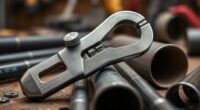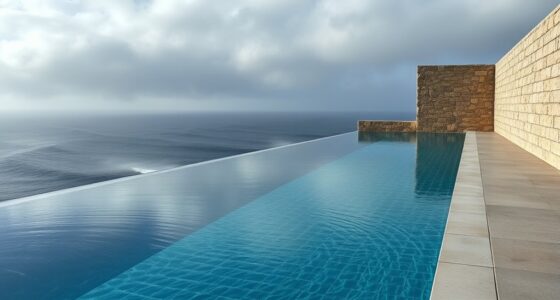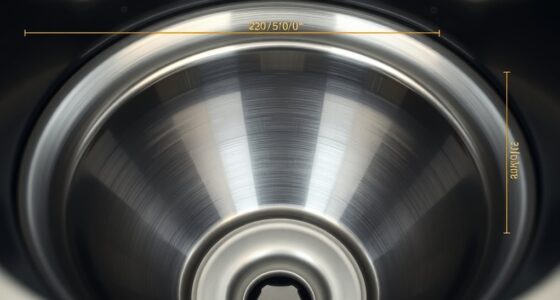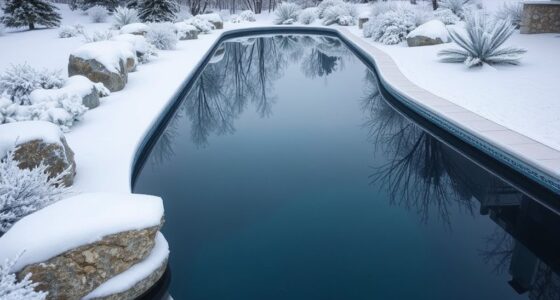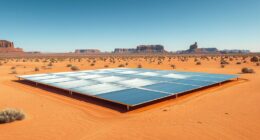To optimize your infinity pool for energy efficiency, choose the right pump size and consider models with variable speed drives (VFDs) to match flow needs precisely. Design your plumbing with straight pipes, minimal bends, and smaller diameters to reduce resistance. Incorporate smart technology for automatic adjustments and monitoring. Regular maintenance guarantees longevity and savings. For more insights on advanced systems and future innovations, explore how these elements work together seamlessly.
Key Takeaways
- Select appropriately sized, energy-efficient pumps with variable speed options to match pool size and circulation needs.
- Implement smart VFDs to precisely control pump speed, reducing energy consumption and prolonging equipment lifespan.
- Design plumbing layouts with straight pipes, minimal bends, and optimal sizing to minimize resistance and energy loss.
- Incorporate smart controls and sensors for real-time system monitoring, scheduling, and early issue detection.
- Use eco-friendly materials and integrate renewable energy sources like solar panels to enhance sustainability and efficiency.
Choosing the Right Pump for Energy Efficiency

Selecting the right pump is crucial for maximizing energy efficiency in your infinity pool. You need a pump that matches your pool’s size and circulation needs without overworking. Larger or more powerful pumps use more energy than necessary, so choosing a pump with the correct flow rate is essential. Look for energy-efficient models with variable speed options, which allow you to adjust flow based on demand. A pump with a high efficiency rating reduces energy consumption and operational costs. Additionally, consider the pool’s plumbing layout, as a well-designed system minimizes resistance and energy loss. Investing in the right pump ensures you maintain ideal water circulation while keeping energy use low, ultimately saving you money and supporting sustainable operation. Understanding the Vortex can help optimize circulation patterns and improve overall system efficiency.
How Variable Frequency Drives Optimize Pool Circulation
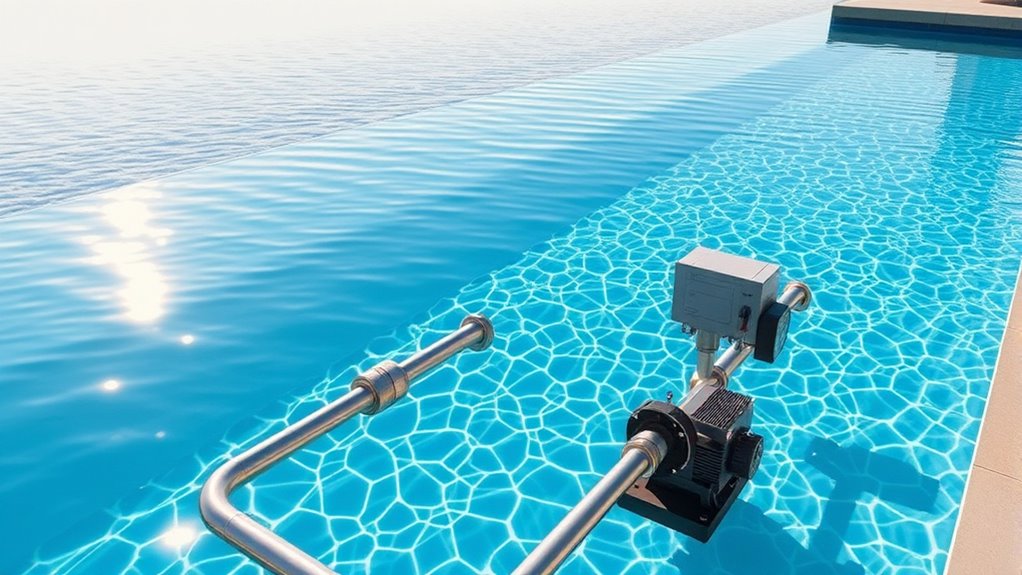
Variable frequency drives give you precise control over your pool’s flow, ensuring ideal circulation without wasting energy. By adjusting speed based on demand, you can save on energy costs and reduce wear on your equipment. This not only keeps your pool running efficiently but also extends the life of your system. Incorporating proper sizing and load‑planning helps optimize performance and energy savings even further.
Precise Flow Control
When it comes to optimizing pool circulation, precise flow control plays a pivotal role, and Variable Frequency Drives (VFDs) are key to achieving this. VFDs adjust the pump speed to match real-time demand, ensuring consistent water flow without waste. This precision prevents over-pumping, reduces noise, and minimizes energy consumption, creating a more efficient and peaceful environment. Imagine a pool where water moves perfectly, no more choppy currents or stagnant spots. With VFDs, you gain confidence in your pool’s performance and longevity. Here’s how it feels:
| Control Level | Effect on Pool | Emotional Impact |
|---|---|---|
| Precise | Consistent flow | Peace of mind |
| Adaptive | Energy-efficient | Satisfaction |
| Responsive | Optimal circulation | Confidence |
Understanding how track development enhances the narrative flow can help you better appreciate the seamless operation of a well-optimized pool system.
Energy Cost Savings
By dynamically adjusting pump speeds to match real-time demand, VFDs substantially reduce energy consumption in your pool system. Instead of running at full speed constantly, VFDs modulate the pump’s power, ensuring it only uses what’s necessary. This targeted approach cuts down on wasted energy and lowers your utility bills. Additionally, operating pumps at variable speeds minimizes stress on equipment, reducing maintenance costs over time. You’ll also experience quieter operation and less wear and tear. By optimizing flow rates based on actual needs, VFDs maximize efficiency without sacrificing circulation quality. Moreover, integrating Kia Tuning principles such as performance upgrades can further enhance system responsiveness and durability. Overall, integrating VFDs into your infinity pool setup results in significant long-term savings, making your pool more sustainable and cost-effective while maintaining peak performance.
Extended Equipment Life
Have you ever wondered how to extend the lifespan of your pool equipment? Using VFDs helps by adjusting pump speed to match circulation needs, reducing stress on motors and components. Less strain means fewer breakdowns and lower maintenance costs over time. Additionally, VFDs prevent frequent on/off cycling, which can wear out parts faster. Proper plumbing layouts and optimized pump operation also contribute to equipment longevity. Here’s a quick comparison:
| Benefit | Effect |
|---|---|
| Reduced wear & tear | Longer-lasting pumps and filters |
| Lower energy use | Less strain on electrical parts |
| Smoother operation | Fewer sudden stops or starts |
| Fewer repairs | Cost savings over the years |
| Consistent flow | Maintains equipment integrity |
Designing a Plumbing System for Minimal Energy Use
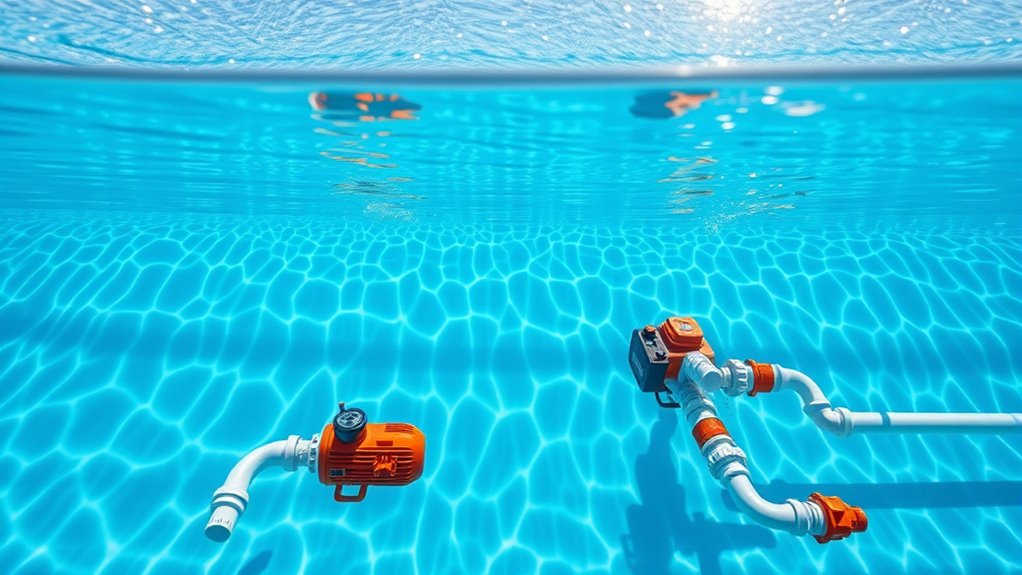
You can save energy by planning your pool’s pipe routing carefully to minimize resistance and flow losses. Using variable speed pumps allows you to match circulation rates to your needs, reducing unnecessary energy consumption. Combining these strategies helps create a plumbing system that’s both efficient and eco-friendly. Additionally, selecting appropriately sized pipes can help prevent flow restrictions that increase energy use.
Optimized Pipe Routing
Optimized pipe routing is essential for reducing energy consumption in infinity pools. When designing your plumbing system, keep pipe lengths as short as possible to minimize friction losses. Use straight runs instead of sharp bends, which can cause flow restrictions and increase pump workload. Prioritize a layout that maintains consistent flow directions, reducing turbulence and pressure drops. Ensure pipe sizes are correctly matched to flow requirements; undersized pipes increase resistance, forcing the pump to work harder. Also, avoid unnecessary loops or complex pathways that add resistance. Properly planned routing not only conserves energy but also improves overall system efficiency and longevity. By focusing on streamlined, direct pipe pathways, you help guarantee your infinity pool operates smoothly while consuming the least energy possible. Additionally, consulting water flow dynamics can help optimize your system design further for maximum efficiency.
Variable Speed Pumping
Implementing variable speed pumping in your infinity pool’s plumbing system allows for precise control of flow rates, markedly reducing energy consumption. Instead of running your pump at full capacity constantly, a VFD (Variable Frequency Drive) adjusts the motor speed based on real-time demand. This means you can lower the flow rate during periods of minimal circulation, saving significant energy. When higher flow is necessary, the pump ramps up smoothly, maintaining efficiency without sudden power surges. Properly sizing and programming your VFD ensures peak performance and minimal waste. Additionally, variable speed pumping reduces wear on equipment and decreases noise levels. Eco-friendly materials are increasingly popular among consumers and can be incorporated into the system for sustainability. Overall, integrating VFDs into your system maximizes energy use, cuts costs, and extends the lifespan of your pool’s components.
Integrating Smart Technology for Automated Pool Management
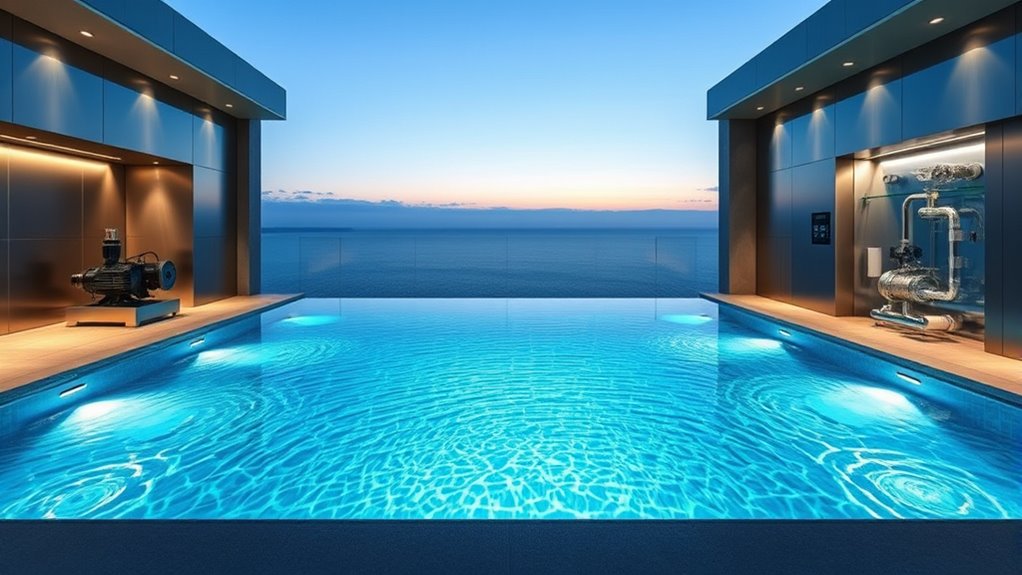
Integrating smart technology into infinity pools allows for seamless and precise management of various pool functions. With automated controls, you can adjust pump speeds, water chemistry, and lighting remotely through a smartphone or centralized system. These systems continuously monitor water temperature, pH levels, and filtration, making real-time adjustments to optimize energy efficiency and water quality. You’ll receive alerts for maintenance needs or system issues, helping prevent problems before they escalate. Smart technology also enables scheduling, ensuring pumps and accessories operate only when needed, reducing energy waste. By integrating these systems, you gain effortless control and enhanced pool performance, all while minimizing energy consumption. Implementing reliable, reader-focused content can help you make informed decisions about your smart pool setup. This approach simplifies management and ensures your infinity pool remains pristine, energy-smart, and responsive to your lifestyle.
Maintenance Tips to Ensure Long-Term Performance and Savings
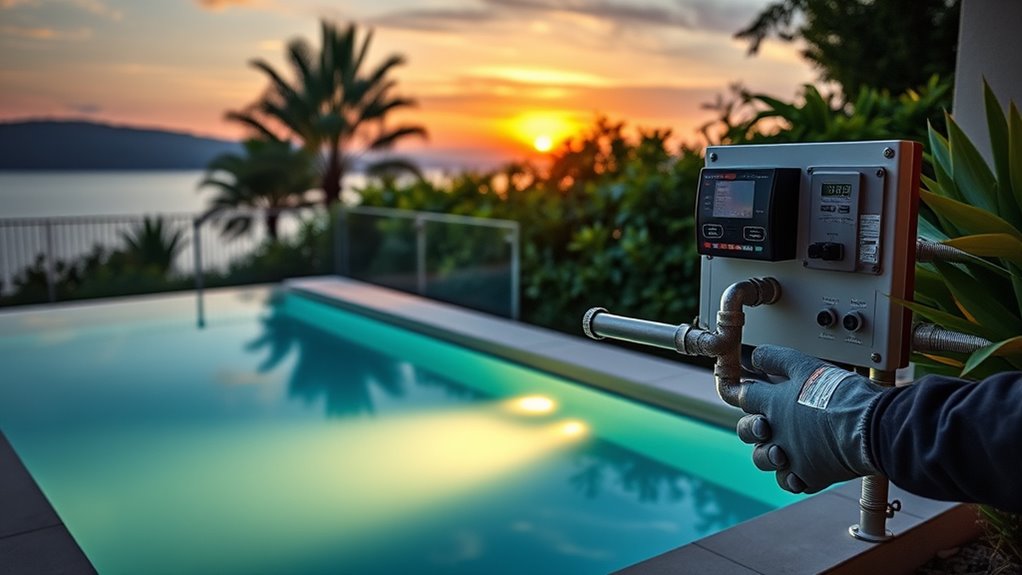
Regular maintenance is essential to keep your infinity pool performing at its best and to save on long-term costs. Start by regularly inspecting and cleaning your filters to prevent debris buildup that can strain your pump and reduce efficiency. Check your pump and VFD settings periodically, ensuring they operate within ideal ranges. Keep an eye on water levels and maintain proper chemical balance to prevent corrosion and algae growth. Lubricate moving parts and replace worn-out seals or gaskets promptly. Clear any obstructions from plumbing lines and ensure valves function smoothly. Regularly monitor energy consumption to identify inefficiencies early. Staying diligent with routine upkeep not only prolongs your pool’s lifespan but also maximizes energy savings, keeping your infinity pool beautiful and cost-effective over time. Additionally, consider implementing energy-efficient pump configurations and plumbing layouts to further optimize performance and reduce operational costs.
Comparing Traditional and Modern Pool Pump Systems

Modern pool pump systems offer considerable improvements over traditional models, especially when it comes to energy efficiency and ease of operation. Unlike older single-speed pumps that run at a constant speed, modern variable frequency drive (VFD) pumps automatically adjust their speed based on your pool’s needs. This means you use less energy while maintaining ideal circulation. Traditional pumps tend to waste power by running at full speed regardless of demand, resulting in higher energy costs. Modern systems also offer smarter controls that let you program schedules and monitor performance remotely. Overall, switching to a modern pump can notably reduce your energy bills, extend equipment lifespan, and improve pool water quality with less effort on your part. Additionally, incorporating smart controls can further optimize system performance and help identify potential issues early.
Future Trends in Sustainable Infinity Pool Design
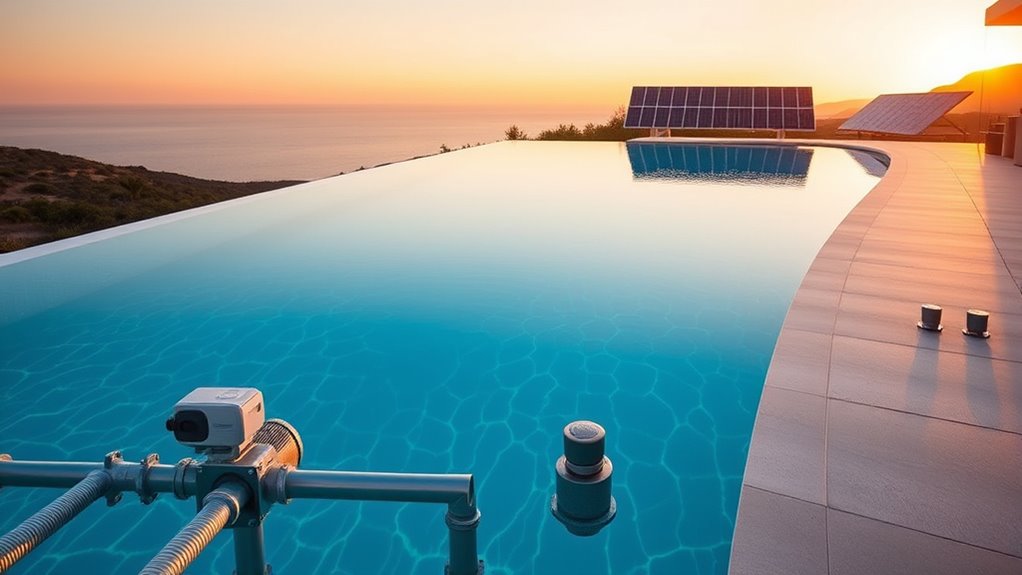
As sustainability becomes a priority in luxury landscape design, future infinity pools are increasingly adopting eco-friendly materials and energy-efficient features. You’ll see pools constructed with recycled metals, low-impact concrete, and sustainable woods that blend seamlessly with natural surroundings. Advanced technology plays a key role, such as integrated solar panels that power filtration systems or LED lighting that reduces energy use. You might also encounter:
- Self-cleaning surfaces that minimize chemical use
- Water recycling systems to conserve resources
- Smart sensors optimizing pump and filter operation
- Green roofs or walls enhancing insulation and biodiversity
These innovations not only reduce environmental impact but also elevate your pool’s beauty and efficiency, creating a luxurious yet sustainable oasis.
Frequently Asked Questions
How Do I Determine the Optimal Pump Size for My Infinity Pool?
You determine the ideal pump size for your infinity pool by calculating the required flow rate based on your pool’s volume and turnover time. Measure your pool’s volume in gallons or liters, then decide how often you want the water to cycle (usually 8-12 hours). Consult pump specifications to find one that provides the necessary gallons per minute (GPM), ensuring efficient circulation without overworking the pump.
What Are the Cost Differences Between Standard and Energy-Efficient Pump Systems?
Energy-efficient pumps typically cost 20-50% more upfront than standard pumps, but they save you money in the long run through lower energy bills. Standard pumps are cheaper initially but consume more power over time, leading to higher operating costs. Investing in an energy-efficient system can pay off within a few years, especially if you run your pool frequently. Consider your long-term savings when choosing between the two options.
Can Smart Technology Fully Automate All Pool Maintenance Tasks?
Sure, your smart pool can practically run itself—if you believe robots will replace poolside lounging. In reality, while smart tech can automate many tasks like cleaning and chemical balancing, it’s not foolproof. You’ll still need occasional human oversight for troubleshooting and fine-tuning. Think of it as having a diligent assistant, not a magic genie—fully automated? Not quite. But it’s pretty close!
How Often Should I Service My Pool’s VFDS and Plumbing Components?
You should service your pool’s VFDs and plumbing components at least once a year, or more frequently if you notice issues like unusual noises, leaks, or decreased efficiency. Regular inspections help catch problems early, preventing costly repairs. Keep an eye on filter pressure and flow rates, and clean or replace filters as needed. Scheduling professional maintenance guarantees your system runs smoothly, maximizing energy savings and prolonging equipment lifespan.
Are There Any Government Incentives for Installing Energy-Efficient Pool Equipment?
You might be surprised to find that many government programs offer incentives for installing energy-efficient pool equipment like VFDs and smart pumps. These incentives aim to reduce energy consumption and environmental impact. Check with local or federal agencies, as rebates and tax credits can substantially offset costs. Your pool upgrade could not only save you money in the long run but also contribute to a greener, more sustainable environment.
Conclusion
Imagine your infinity pool gliding silently, water shimmering effortlessly under the sun, powered by smart, energy-efficient systems. By choosing the right pump, optimizing circulation with VFDs, and designing a smart plumbing layout, you create a tranquil oasis that’s both beautiful and sustainable. With regular maintenance and future-ready technology, your pool becomes a seamless sanctuary—a breathtaking retreat that saves energy and elevates your outdoor experience. Plunge into smarter, greener infinity pool design today.

